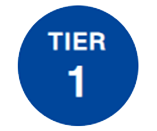The Arizona Department of Administration provides medical insurance to state employees, including University of Arizona employees and their legal dependents. Review the information below carefully for details on your options.
UPDATES:
- Aug. 1, 2023 - Gender-Affirming Surgery Exclusion Removed From ADOA Health Plans. Learn more
- March 2, 2023 - New Health Reimbursement Arrangement for Gender-Affirming Surgery and Fertility Treatments. Learn more
Steps and Considerations When Choosing a Medical Plan
Note: You may only choose a medical plan during new hire benefits enrollment, the annual fall benefits open enrollment period or if you experience a qualified life event.
Step 1: Compare Medical Plan Options
Quick downloads: Plan comparison chart | 2024 medical premiums | Definitions & Quick Facts
Triple Choice Plan (TCP)
The TCP is a single plan for which you pay one premium.
In the TCP, you have access to two tiers of in-network providers plus the option to go out-of-network with a third tier. If you visit an in-network provider, you pay copays for service; out-of-network you pay 50% coinsurance.
The provider you choose determines your deductible. If your provider is in Tier 1, your deductible is lower than if you choose a Tier 2 or Tier 3 provider. Note: all Arizona hospitals, emergency room providers, and urgent care providers are Tier 1.
You are responsible for the cost of services until you meet the deductible. Once the deductible is met, you will pay copays for services until you reach the out-of-pocket maximum. Once you reach the out-of-pocket maximum, you pay nothing.
All preventive services are free and do not count toward the deductible.
Plan Documents - TCP
2024 TCP Summary of Benefits and Coverage - English (PDF)
2024 TCP Summary of Benefits and Coverage - Spanish (PDF)
TCP Summary Plan Description (PDF)
High-Deductible Health Plan (HDHP) with Health Savings Account (HSA)
The HDHP has lower premiums and is paired with an HSA.
You are responsible for the cost of services until you meet the deductible. Once you meet the deductible, you pay 10% (coinsurance) and the plan pays 90% until you reach the out-of-pocket maximum. Once you reach the out-of-pocket maximum, you pay nothing.
With the HDHP, the University will open an account on your behalf with Optum Bank and contribute to your HSA every pay period ($30 per pay period for employee-only and $60 per pay period for family). You may choose to contribute as well for additional tax savings.
Your HSA monies can be used toward your deductible, coinsurance, or other qualified medical expenses. All preventive services are free and do not count toward the deductible. You do, however, pay a copay for preventive prescriptions.
Plan Documents - HDHP With HSA
2024 HDHP Summary of Benefits and Coverage - English (PDF)
2024 HDHP Summary of Benefits and Coverage - Spanish (PDF)
HDHP Summary Plan Description (PDF)
You are ineligible for the HDHP if you have a Health Reimbursement Account, or have coverage through Medicare or TRICARE. You also cannot be claimed as a dependent on another person’s tax return.
Step 2: Compare Insurance Carriers
The provider networks may differ between the two insurance carriers. Search for your providers with both carriers to help determine your best choice. Note that you may see more than one tier designation next to Tier 1 and Premium Care providers. Tier 1, for instance, will also display the in-network check mark.
Blue Cross Blue Shield of Arizona
Find network doctors and facilities
- Visit www.azblue.com/home
- Scroll down and click “Find a Doctor.”
- You can log in and search as a BCBSAZ member or browse as a guest.
- Enter search parameters: Coverage Year: 2024
- Type of Coverage: Employer-Provided
- Type of Provider: Medical
- Network: Blue Preferred Care Tiers (“Triple Choice Plan” for State of AZ employees) OR High Deductible Health Plan
- Hit “Search” and enter your location
Note: Tier 1 providers are only located in Arizona. Outside of Arizona, in-network providers will always be Tier 2.
UnitedHealthcare
Find network doctors and facilities
- Visit www.whyuhc.com/stateofaz
- Click on the “Providers” tab.
- Select the applicable medical plan
- Enter your search location
Note: Tier 1 providers are located in Arizona and also outside of Arizona.
Triple Choice Plan (TCP)
- This plan has higher premiums but lower deductibles.
- For the lowest deductible of $200 (single) or $400 (family), you must visit only Tier 1 providers. If you visit Tier 2 providers, your deductible will increase to $1,000 (single) or $2,000 (family).
- You may have to change your provider to achieve the lowest out-of-pocket expenses.
- This plan has fixed copays and more predictable costs at the time of service. Because you pay a fixed copay rather than coinsurance, this could mean lower out-of-pocket costs if you experience unexpected medical expenses.
High-Deductible Health Plan (HDHP) With Health Savings Account (HSA)
- This plan has higher deductibles of $1,500 (single) or $3,000 (family) but much lower premiums.
- If you are generally healthy and receive mostly preventive and routine care, your out-of-pocket costs may be less.
- If you have unexpected medical expenses, you may experience higher out-of-pocket costs because of the deductible and less predictable amount of 10% coinsurance. However, in most cases, the copays on the TPC are more than 10% of the cost of care.
- The University contributes to an HSA account each pay period to help you cover the deductible, coinsurance, or other qualified medical expenses. Annually, this contribution is $720 (single) or $1,440 (family) - about half of the deductible.
- You may make pre-tax contributions to the HSA through payroll deduction, allowing you to build tax-free savings to pay for healthcare. You also do not pay taxes when you withdraw the money to pay for your medical expenses.
- All funds in the HSA belong to you. There is no use-it-or-lose-it requirement, and you keep your HSA even if you leave the University.
Frequently Asked Questions
General
Select the University Benefits tile in UAccess to review your current benefit elections. You may need to log in with your UArizona NetID and password.
All ADOA and University medical insurance plans only cover emergency treatment for accidents or sudden illnesses. For international insurance coverage, you will have to purchase a plan from an insurance company that matches your needs.
If you are traveling on University business, you are also covered for liability, work-related injuries, and emergency assistance. For details on required preparation for international travel, see Risk Management's International Travel Insurance page.
Under the HDHP - All BUMG physicians are in-network with both Blue Cross Blue Shield and UnitedHealthcare.
Under the TCP - All BUMG physicians are Tier 1 with Blue Cross Blue Shield. With UnitedHealthcare, BUMG physicians may be Tier 1 or Tier 2. Please check the UnitedHealthcare provider directory.
Beginning Aug. 11, 2023, the state of Arizona's health plan will cover expenses for medically necessary gender-affirming surgery. Learn more about the removal of this coverage exclusion.
The state health plans currently exclude fertility treatments.
To help supplement the state health plans and support employee well-being, the University of Arizona has established a Health Reimbursement Arrangement. This HRA aims to assist University employees with out-of-pocket expenses related to gender-affirming surgery and fertility treatments. Learn more about the HRA and how to submit claims for funds.
Physical Insurance Card: Your insurance carrier will mail you an insurance card, which helps identify your coverage. Present your insurance card to your provider.
Digital Insurance Card: You can also get a digital card through an online account with your insurance carrier. Set up or login to your accounts using the following links:
Deductibles
Triple Choice Plan
Once a single family member meets the single deductible, that family member begins paying copayments for visits. The remaining amount of the family deductible may be met by any combination of the other family members before they will begin paying copayments.
High Deductible Health Plan
Any combination of family members must meet the deductible before coinsurance begins.
The Tier 1 deductible applies to Tier 2 and vice versa. For example, once you meet the Tier 1 deductible of $200 single/$400 family, you will only pay copays for any Tier 1 provider you visit. If during the year, you visit a Tier 2 provider, the $200/$400 deductible you've already paid will count towards the higher Tier 2 deductible of $1,000 single/$2,000 family. You will pay toward that higher deductible each time you visit a Tier 2 provider, but your Tier 1 provider visits will continue to require only copays. If you use doctors in both tiers, the most you will pay toward your deductible is $1,000 individual/$2,000 family.
Triple Choice Plan
In the TCP, prescriptions do not count toward the deductible. You always pay a fixed copay.
High Deductible Health Plan
In the HDHP, prescriptions that are not considered preventive medications do count toward the deductible.
For formulary information, visit medimpact.com/plan/adoa. Generic Login:
- Username: EPOADOA3
- Password: Arizona202!
Triple Choice Plan
The following services are always Tier 1:
- All Arizona hospitals, emergency room providers, ambulance services, and urgent care providers.
- All services received at Campus Health.
- Telehealth Services/Virtual Visit providers, including Doctor on Demand, BlueCare Anywhere, and UnitedHealthcare app.
- Behavioral health, mental health, and substance abuse services.
- Surgery services, which require the use of a Center of Excellence (UHC) or Blue Distinction Specialty Care (BCBSAZ).
- Chiropractors.
Tier 1 providers must meet specific quality and efficiency metrics related to good health outcomes—that is, they demonstrate they provide good value for your healthcare dollars and follow established treatment protocols.
These metrics are reviewed regularly to determine if designations need adjustments, and a provider may be added to Tier 1 at any time.
No. Each doctor in a practice will have their own tier designation.
Always check your provider’s tier status with the network prior to obtaining services.
Blue Cross Blue Shield
There are no Tier 1 providers outside of Arizona. All in-network providers in other states will be Tier 2.
UnitedHealthcare
Does have Tier 1 providers outside of Arizona. Check the UHC provider directory (See link and instructions in the Compare Insurance Carriers section).
Yes. However, if a provider moves from Tier 1 to Tier 2 in the middle of the year, the Tier 1 designation will be honored for the remainder of the calendar year.
No. The TCP is one plan. You pay one premium and can choose healthcare providers in any of the three tiers.
Your overall healthcare expenses will be lower if you choose only Tier 1 providers.
High Deductible Health Plan with Health Savings Account
To be eligible to contribute to an HSA you:
- Cannot have any secondary insurance, including Medicare or Tricare.
- Cannot have a healthcare reimbursement account.
- Cannot be claimed as a dependent on another person’s tax return.
If you are deemed ineligible, your and the University's contributions could be subject to both income and excise tax. If you have questions regarding your eligibility, contact a tax or financial advisor.
| 2024 | Annual Max Contributions (Employee + Employer) | Monthly Max Employee Contribution | Employer Contribution | ||
|---|---|---|---|---|---|
| Under age 55 | Age 55 and older | Under age 55 | Age 55 and older | Per month | |
| Single | $4,150.00 | $5,150.00 | $285.83 | $369.17 | $60.00 |
| Family | $8,300.00 | $9,300.00 | $571.67 | $655.00 | $120.00 |
The lower negotiated rate is used for determining your coinsurance. The negotiated rate is also used to determine how much would apply to your deductible.
As part of the enrollment process, the HSA administrator may send a letter to your home address requesting identifying information, such as your name, date of birth, address and social security number. The process is required under the U.S. Patriot Act.



